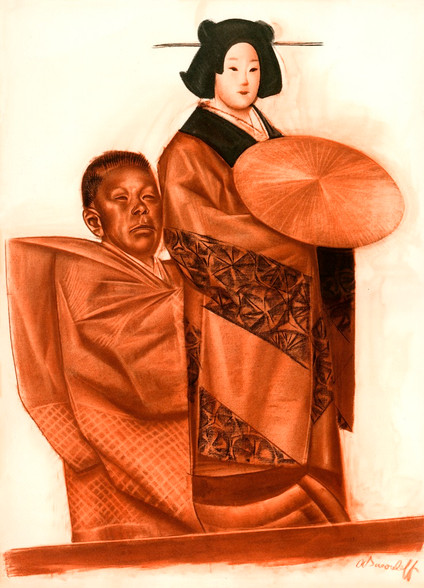 Loading... Please wait...
Loading... Please wait...All prices are in All prices are in EUR
Categories
- Home
- Giclee Prints
- Giclee Art Deco Kabuki Theater Iacouleff Bunraku puppet
- Home
- Giclee Prints
- Kabuki Theater- Art Deco
- Giclee Art Deco Kabuki Theater Iacouleff Bunraku puppet
Product Description
Giclee, Kabuki, Japanese Theater, Bunraku, Marionette, Doll, Puppet, Alexandre Iacovleff, Aleksandr Yakovlev, Art Deco, Japan
Archival Limited Edition Giclee print after the original heliogravure by Russian artist Alexander Evgenievich Iacovleff for Kabuki Japonais, published in 1838, the year of his death.
Scene Description: In this scene Iacovleff illustrates the craft of the principal animator of theater marionettes, Bunrakuza, maneuvers one of the dolls. He manipulates the formal costumed doll from the shoulders. The Doll represents Tonase, a female member of the Kakagawa Honzo, journeying to Kyoto. This scene is from the well-known play Chusningura.This play is a fictionalized account relating to the historical incident involving the forty-seven rōnin and their mission to avenge the death of their master, Asano Naganori.
Print Size = 28 x 38 cm / 11 1/6 x 15 1/6 inches
Issued with Archival Limited Edition Certificate
Bunraku Theater
Bunraku also goes by the name Ningyō jōruri. and is a form of traditional Japanese Puppet Theater. It was founded in the early 1600s in Osaka. A bunraku performance takes three dedicated performers to achieve: the Puppeteer (Ningyōtsukai), the Chanters (Tayū), and the Musicians (shamisen). Occasionally other instruments such as taiko drums will be used. In Japanese theatre history, kabuki and the puppet theatre are closely connected. Throughout its history kabuki has borrowed plays as well as acting techniques from the jōruri puppet tradition, and some of the most famous pieces are staged by both traditions.
Product Videos
-
 Ningyo Johruri...UNESCO: Representative List of the Intangible Cultural Heritag...
Ningyo Johruri...UNESCO: Representative List of the Intangible Cultural Heritag...











